ARE THESE PHOTOS OF BILLY THE KID?
by Joelle Steele
 When people send me photos to compare and wonder how I get back to them so quickly with a "no, it's not a match," it's because the photos failed to make it past the first two steps I take in comparing faces: 1) looking at the ears, if visible, to see if they match, and/or 2) aligning the pupils and sizing the irises to see if the facial features line up. These steps generally take a total of about 10-15 mintes to do. It's only if the ears or face are close to a match that I analyze and measure the face further.
When people send me photos to compare and wonder how I get back to them so quickly with a "no, it's not a match," it's because the photos failed to make it past the first two steps I take in comparing faces: 1) looking at the ears, if visible, to see if they match, and/or 2) aligning the pupils and sizing the irises to see if the facial features line up. These steps generally take a total of about 10-15 mintes to do. It's only if the ears or face are close to a match that I analyze and measure the face further.
But then there are face and ear comparisons that are close in some ways and not in others. Those are always non-matches, because in authenticating identities, it's a 100% match or it's not a match at all. And that brings us to Billy the Kid, born William Henry McCarty, Jr. ca. 1859 and died July 14, 1881 at the age of 21. He was also known as William Henry Bonney and Henry Antrim. The most detailed description of Billy's face comes from Pat Garrett's book, "The Authentic Life of Billy, the Kid." This book also includes an image of the Upham tintype which appears later in this article. Garrett was a New Mexico sheriff who knew Billy, pursued him for killing two men, and then killed Billy in 1881. Here's Pat Garrett's written description of Billy:
"[H]is hair was of a darker brown, glossy, and luxuriant; his eyes were a deep blue, dotted with spots of a hazel hue ... His face was oval in form, the most noticeable feature being two projecting upper front teeth..."
Other descriptions of his face can be found in the WPA Files of the Library of Congress, compiled during the Federal Writers Project, 1936-1940. Francisco Gomez states that Billy had:
"... light brown hair, blue eyes, and rather big front teeth." Jose Garcia Y Trujillo said that "His forehead was big. His eyes were blue."
He has also been described by various other people in their first-hand accounts as having blue eyes, a light complexion, crooked and protruding upper front teeth, a small mouth with narrow lips, wavy sandy blonde to light brown hair, and an aquiline nose (also known as a hooked, beaked, or Roman nose). He is also said to have been beardless, and was known for wearing a sugarloaf sombrero hat (see the Upham tintype below). He is also described as having a long neck and an oval face.
These descriptions seem to fit what can be seen in the Upham tintype. The tintype sold at auction for $2 million in 2016 to a billionnaire collector of western memorabilia. There's more to that story, but this is about two other photos believed to be of Billy the Kid: the Furlong photo and a signed carte de visite.
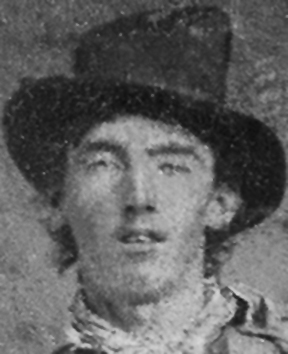
The Upham Tintype (above)
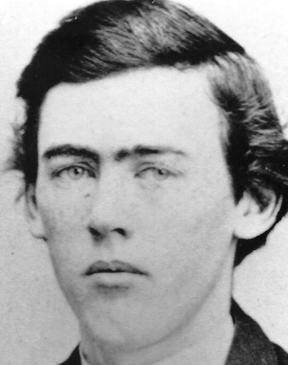
The Furlong Photograph (above)
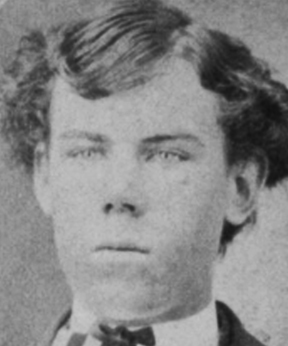
Signed Carte de Visite (above)
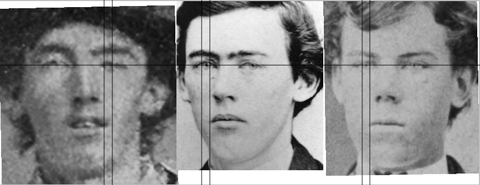
I analyzed the two photos to the right of the Upham image. I looked at the ears first to see if they were a match, but the Upham image is so visually degraded that it's hard to tell what the ears really look like, and while there have been all kinds of digital "restorations" made of the Upham tintype, I don't ever use a digitally restored damaged photo when I'm authenticating an identity of a face in a photo. The details are far too important in a comparison, and there's no way to know what may have been modified - even if only slightly - by the artist doing the restoration. So, because I couldn't do much with the ears in the Upham photo, I looked at the ears of the other two faces. But their ears are not clear enough and one is partly obscured, so while their ears do not appear to be a match, I can't tell for sure.
So, on to my second step when I can't do anything with the ears. I aligned the pupils, which meant tilting the photos a little to get the pupils all on a level horizontal line. Then I made the irises the same size. I use this technique because eyes remain stable in size once a person is about 16 or so and throughout the rest of their life. Tintypes are usually laterally reversed, but that doesn't affect this kind of measurement, so I didn't reverse it.
The eyes revealed that the face in the middle photo (the Furlong) is smaller than the other two faces because his eyes are larger in proportion to his face. So, while the eyes and chin of the middle face look like a possible match, the rest of the face doesn't match the Upham image. The nose is also not a match because it is not an aquiline or Roman nose like the one in the Upham and in descriptions of Billy.
Now we come to the photo on the right (the carte de visite). This photo is signed W.H. Bonney, but this does not mean it is a legitimate signature of Billy the Kid. Billy was believed to have been literate, but there are at least three existing signatures attributed to him (below), and the one in the middle is the one on the carte de visite. In addition to being a court-certified expert in face and ear identification, I am also a court-certified forgery expert, so I can tell you with 100% certainty, that these three signatures were not signed by the same person. They are associated with things Billy did, but he didn't sign all of them. Which one, if any, is legitimate, we will probably never know.
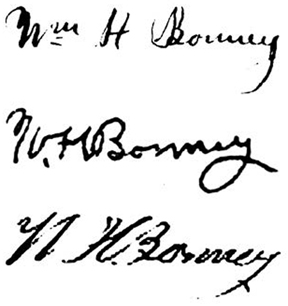
But back to the face on the carte de visite. If we are to believe that he signed it as being his own image, then we have a real dilemma, because the face does not match the Upham tintype at all. The eyes don't match. The eyebrows don't match. The nose doesn't match. The philtrum (the space between the base of the nose and the top of the upper lip) doesn't match. The hair is a little fancier, but I never take hair styles into consideration as they can and do change, sometimes frequently.
THE FINAL DECISION
My final decision on this analysis is that neither the Furlong nor the carte de visite match each other, and neither matches the Upham tintype.
SUMMARY
Hoping that your photo is of a historic figure is not enough to make it so. Neither is comparing your photo to a poor quality image of a known historic figure and trying to make the two a match by using careless, simplistic, or inadequate analytical methods, or by relying on anything other than careful and thorough analysis of facial features. But there's just enough visual information in the Upham tintype to compare it.

